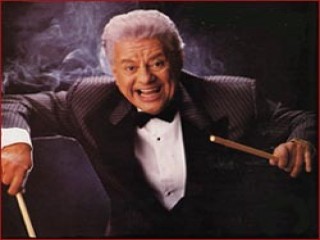
Tito Puente biography
Date of birth : 1923-04-20
Date of death : 2000-05-31
Birthplace : New York City, New York, U.S.
Nationality : American
Category : Famous Figures
Last modified : 2011-07-01
Credited as : Jazz and salsa musician, Mambo, El Rey
0 votes so far
Tito Puente is probably the most beloved symbol of Latin jazz. But more than that, Puente managed to keep his music remarkably fresh over the decades; as a timbales virtuoso, he combined mastery over every rhythmic nuance with old-fashioned showmanship -- watching his eyes bug out when taking a dynamic solo was one of the great treats for Latin jazz fans. A trained musician, he was also a fine, lyrical vibraphonist, a gifted arranger, and played piano, congas, bongos, and saxophone. His appeal continues to cut across all ages and ethnic groups, helped no doubt by Santana's best-selling cover versions of "Oye Como Va" and "Para Los Rumberos" in 1970-1971, and cameo appearances on The Cosby Show in the 1980s and the film The Mambo Kings in 1992. His brand of classic salsa is generally free of dark undercurrents, radiating a joyous, compulsively danceable party atmosphere.
Rooted in Spanish Harlem, of Puerto Rican descent, Puente originally intended to become a dancer but those ambitions were scotched by a torn ankle tendon suffered in an accident. At age 13, he began working in Ramon Olivero's big band as a drummer, and later he studied composing, orchestration, and piano at Juilliard and the the New York School of Music. More importantly, he played with and absorbed the influence of Machito, who was successfully fusing Latin rhythms with progressive jazz. Forming the nine-piece Piccadilly Boys in 1947 and then expanding it to a full orchestra two years later, Puente recorded for Seeco, Tico, and eventually RCA Victor, helping to fuel the mambo craze that gave him the unofficial -- and ultimately lifelong -- title "King of the Mambo," or just "El Rey." Puente also helped popularize the cha-cha during the 1950s, and he was the only non-Cuban who was invited to a government-sponsored "50 Years of Cuban Music" celebration in Cuba in 1952.
Among the major-league congueros who played with the Puente band in the '50s were Mongo Santamaria, Willie Bobo, Johnny Pacheco, and Ray Barretto, which resulted in some explosive percussion shootouts. Not one to paint himself into a tight Latin music corner, Puente's range extended to big-band jazz (Puente Goes Jazz), and in the '60s, bossa nova tunes, Broadway hits, boogaloos, and pop music, although in later years he tended to stick with older Latin jazz styles that became popularly known as salsa. In 1982, he started reeling off a string of several Latin jazz albums with octets or big bands for Concord Picante that gave him greater exposure and respect in the jazz world than he ever had.
An indefatigable visitor to the recording studios, Puente recorded his 100th album, The Mambo King, in 1991 amid much ceremony and affection (an all-star Latin music concert at Los Angeles' Universal Amphitheatre in March 1992 commemorated the milestone), and he kept adding more titles to the tally throughout the '90s. He also appeared as a guest on innumerable albums over the years, and such jazz stars as Phil Woods, George Shearing, James Moody, Dave Valentin, and Terry Gibbs played on Puente's own later albums. Just months after accepting his fifth Grammy award, he died on June 1, 2000. Several months later, Puente was recognized at the first annual Latin Grammy Awards, winning for Best Traditional Tropical Perfomance for Mambo Birdland.
















